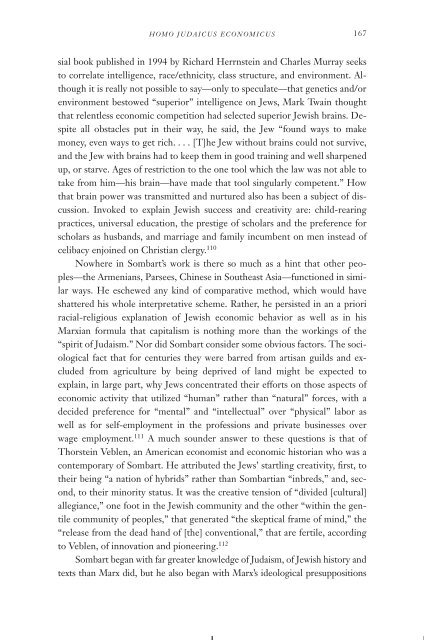41845358-Antisemitism
41845358-Antisemitism
41845358-Antisemitism
Create successful ePaper yourself
Turn your PDF publications into a flip-book with our unique Google optimized e-Paper software.
HOMO JUDAICUS ECONOMICUS<br />
167<br />
sial book published in 1994 by Richard Herrnstein and Charles Murray seeks<br />
to correlate intelligence, race/ethnicity, class structure, and environment. Although<br />
it is really not possible to say—only to speculate—that genetics and/or<br />
environment bestowed “superior” intelligence on Jews, Mark Twain thought<br />
that relentless economic competition had selected superior Jewish brains. Despite<br />
all obstacles put in their way, he said, the Jew “found ways to make<br />
money, even ways to get rich. ...[T]he Jew without brains could not survive,<br />
and the Jew with brains had to keep them in good training and well sharpened<br />
up, or starve. Ages of restriction to the one tool which the law was not able to<br />
take from him—his brain—have made that tool singularly competent.” How<br />
that brain power was transmitted and nurtured also has been a subject of discussion.<br />
Invoked to explain Jewish success and creativity are: child-rearing<br />
practices, universal education, the prestige of scholars and the preference for<br />
scholars as husbands, and marriage and family incumbent on men instead of<br />
celibacy enjoined on Christian clergy. 110<br />
Nowhere in Sombart’s work is there so much as a hint that other peoples—the<br />
Armenians, Parsees, Chinese in Southeast Asia—functioned in similar<br />
ways. He eschewed any kind of comparative method, which would have<br />
shattered his whole interpretative scheme. Rather, he persisted in an a priori<br />
racial-religious explanation of Jewish economic behavior as well as in his<br />
Marxian formula that capitalism is nothing more than the workings of the<br />
“spirit of Judaism.” Nor did Sombart consider some obvious factors. The sociological<br />
fact that for centuries they were barred from artisan guilds and excluded<br />
from agriculture by being deprived of land might be expected to<br />
explain, in large part, why Jews concentrated their efforts on those aspects of<br />
economic activity that utilized “human” rather than “natural” forces, with a<br />
decided preference for “mental” and “intellectual” over “physical” labor as<br />
well as for self-employment in the professions and private businesses over<br />
wage employment. 111 A much sounder answer to these questions is that of<br />
Thorstein Veblen, an American economist and economic historian who was a<br />
contemporary of Sombart. He attributed the Jews’ startling creativity, first, to<br />
their being “a nation of hybrids” rather than Sombartian “inbreds,” and, second,<br />
to their minority status. It was the creative tension of “divided [cultural]<br />
allegiance,” one foot in the Jewish community and the other “within the gentile<br />
community of peoples,” that generated “the skeptical frame of mind,” the<br />
“release from the dead hand of [the] conventional,” that are fertile, according<br />
to Veblen, of innovation and pioneering. 112<br />
Sombart began with far greater knowledge of Judaism, of Jewish history and<br />
texts than Marx did, but he also began with Marx’s ideological presuppositions


